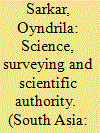| Srl | Item |
| 1 |
ID:
138540


|
|
|
|
|
| Summary/Abstract |
From its inception in 1660, the Royal Society of London has been involved with science internationally. More recently, its work has become part of a growing trend in the science community of nongovernmental organizations supporting international relations by working beyond national boundaries on problems of common interest. Such efforts are consistent with the basic tenets of science, namely, that science provides a non-ideological environment for the participation and free exchange of ideas between people, regardless of cultural, national, or religious backgrounds.
|
|
|
|
|
|
|
|
|
|
|
|
|
|
|
|
| 2 |
ID:
154554


|
|
|
|
|
| Summary/Abstract |
This article traces the journeys of and controversies surrounding the Schlagintweit brothers in ‘India and High Asia’. The brothers were Alpine glaciologists from Germany who were invited by the East India Company in 1854 to complete the Magnetic Survey of the Indian subcontinent on the recommendation of Alexander von Humboldt. This article discusses how the Schlagintweit brothers became the subject of controversy, and how they vanished from the record of the history of surveying as abruptly as they had emerged. Their story calls into question established historiographical narratives about ‘colonial science’ and ‘Western science’ in the subcontinent.
|
|
|
|
|
|
|
|
|
|
|
|
|
|
|
|
| 3 |
ID:
121605


|
|
|
|
|
| Publication |
2013.
|
| Summary/Abstract |
Geoengineering, the "deliberate, large-scale manipulation of the planetary environment in order to counteract anthropogenic climate change" (Shepherd et al. 2009, 1), is attracting increasing interest. As well as the Royal Society, various scientific and government organizations have produced reports on the potential and challenge of geoengineering as a potential strategy, alongside mitigation and adaptation, to avoid the vast human and environmental costs that climate change is thought to bring (Blackstock et al. 2009; GAO 2010; Long et al. 2011; Rickels et al. 2011). "Geoengineering" covers a diverse range of proposals conventionally divided into carbon dioxide removal (CDR) proposals and solar radiation management (SRM) proposals. This article argues that "geoengineering" should not be regarded as a third category of response to climate change, but should be disaggregated. Technically, CDR and SRM are quite different and discussing them together under the rubric of geoengineering can give the impression that all the technologies in the two categories of response always raise similar challenges and political issues when this is not necessarily the case. However, CDR and SRM should not be completely subsumed into the preexisting categories of mitigation and adaptation. Instead, they can be regarded as two parts of a five-part continuum of responses to climate change. To make this case, the first section of this article discusses whether geoengineering is distinctive, and the second situates CDR and SRM in relation to other responses to climate change.
|
|
|
|
|
|
|
|
|
|
|
|
|
|
|
|